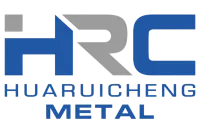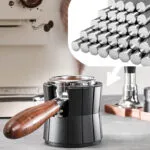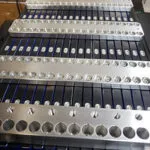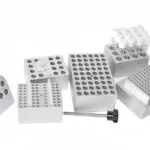Heat Treatment
Heat treatment can be used at different stages of the manufacturing process to change certain properties of a metal or alloy. Heat treatment makes the material stronger, harder, more durable, or more ductile.
What is Heat Treatment?
Heat treatment is a custom metal finishing process involves heating and cooling a metal to precise temperatures. Precisely, heat treatment changes metals’ physical, mechanical, and sometimes chemical properties through heating and cooling. Such properties include ductility, hardness, temperature resistance, formability, machinability, strength, etc.
Precision heat treatment involves heating the metal to a specific temperature to change its microstructure, maintaining the temperature, and cooling it back to room temperature at a particular rate.
There are also four types of heat treatment: hardening, tempering, annealing, and normalizing. Hardening makes the metal stronger but reduces its ductility. It involves slowly heating the part to a high temperature, maintaining the temperature for a specified time, and quenching (rapid cooling by plunging it into water or oil)
Heat treatment methods vary depending on the type of metal material and the specific properties required. It is important for manufacturers to know the suitable heat treatment method to meet their specific needs.
How Does Heat Treatment Work?

Heat treatment alters a metal’s properties by changing its microstructure through controlled heating and cooling. Key processes:
1. Heating
Metal is heated to a specific temperature (e.g., steel to 750–900°C to form austenite).
Alloying elements dissolve, preparing for structural changes.
2. Holding (Soaking)
Maintains temperature to ensure uniformity.
3. Cooling
Fast (Quenching): Forms hard martensite (steel) or locks in dissolved elements (aluminum).
Slow (Annealing): Creates softer, more ductile structures.
4. Secondary Treatments (Optional)
Tempering (Steel): Reduces brittleness after quenching.
Aging (Aluminum/Titanium): Strengthens by forming precipitates.
Which Metals Are Available For Heat Treating?
Many metals can be heat treated to enhance their mechanical properties, such as hardness, strength, toughness, and ductility. Metal alloys such as copper, aluminum, nickel, brass, magnesium, and titanium get heat treated. Below are some of the metals available for heat treatment and the suitable heat treatment types:
1. Cast Iron, Carbon Steel, Martensitic Stainless Steel, and Tool Steel
Heat treatment methods – Hardening, Annealing, Normalizing, Stress Relieving, Case Hardening, Nitriding, and Tempering.
2. Copper and Copper Alloys
Heat treatment methods – Annealing, Ageing, and Quenching.
3. Aluminum
Heat treatment methods – Annealing, Solution heat treatment, Natural and Artificial Ageing.

Heat Treatment FAQs
What is heat treatment?
A controlled process of heating and cooling metals to change their mechanical properties (hardness, strength, ductility) without altering shape.
Why is heat treatment done?
To improve wear resistance, strength, toughness, or machinability, or to relieve internal stresses.
Can you heat treat stainless steel?
Austenitic stainless steel is difficult to heat-treat due to its high nickel content.
Yet, martensitic stainless steel gets hardened using quenching and austenitizing. Austenitizing temperatures range from 980 to 1110°C.
What metals are suitable for heat treatment?
Generally, both ferrous and non-ferrous metals are suitable for heat treatment. But then, different steel grades account for the majority of heat-treated metals.
What’s the difference between annealing and tempering?
Annealing: Heats then slowly cools to soften metal and improve ductility.
Tempering: Done after quenching to reduce brittleness while keeping hardness.













